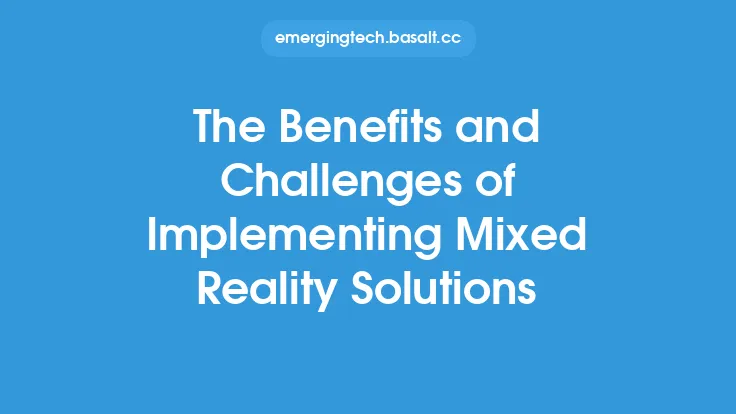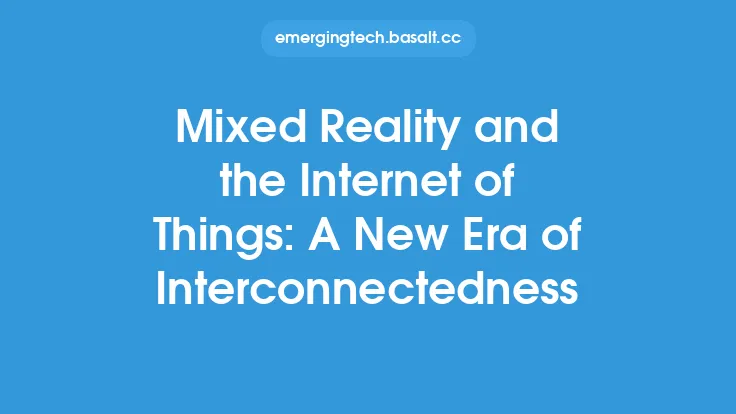The concept of mixed reality (MR) has been gaining significant attention in recent years, particularly in the fields of education and training. By seamlessly blending the digital and physical worlds, MR has the potential to revolutionize the way we learn and acquire new skills. This technology enables users to interact with virtual objects and environments in a highly immersive and interactive manner, making it an ideal tool for educational institutions and training organizations.
Introduction to Mixed Reality in Education
Mixed reality in education can be defined as the use of MR technology to create interactive, immersive, and engaging learning experiences. This can include virtual labs, simulations, and interactive 3D models that allow students to explore complex concepts and systems in a highly interactive and engaging manner. MR can be used to enhance the learning experience in a variety of subjects, including science, technology, engineering, and mathematics (STEM), as well as in fields such as medicine, architecture, and engineering.
Benefits of Mixed Reality in Education
The benefits of MR in education are numerous. Firstly, MR can increase student engagement and motivation by providing a highly interactive and immersive learning experience. This can be particularly beneficial for students who are visual or kinesthetic learners, as MR allows them to interact with complex concepts and systems in a highly tactile and intuitive manner. Additionally, MR can provide students with a safe and controlled environment in which to practice and experiment with new skills and techniques, reducing the risk of accidents and errors. MR can also provide teachers and instructors with a powerful tool for assessing student learning and understanding, allowing them to identify areas where students may need additional support or review.
Technical Requirements for Mixed Reality in Education
In order to implement MR in education, a number of technical requirements must be met. Firstly, a high-performance computer or device is required, capable of rendering complex graphics and simulations in real-time. Additionally, a range of sensors and tracking systems are required, including cameras, accelerometers, and gyroscopes, in order to track the user's movements and interactions. MR software and content must also be developed, using tools such as Unity or Unreal Engine, and must be designed to be highly interactive and engaging. Finally, a range of input devices, such as controllers or gestures, are required, in order to allow users to interact with the virtual environment.
Applications of Mixed Reality in Education
MR has a wide range of applications in education, including virtual labs, simulations, and interactive 3D models. For example, in science education, MR can be used to create virtual labs and simulations, allowing students to conduct experiments and investigations in a safe and controlled environment. In medical education, MR can be used to create highly realistic and interactive simulations, allowing students to practice and develop their clinical skills. In engineering and architecture, MR can be used to create interactive 3D models, allowing students to design and test complex systems and structures.
Case Studies of Mixed Reality in Education
A number of case studies have demonstrated the effectiveness of MR in education. For example, a study at the University of California, Los Angeles (UCLA) used MR to create a virtual lab for teaching chemistry, allowing students to conduct experiments and investigations in a highly interactive and immersive manner. Another study at the University of Cambridge used MR to create a simulation of a human brain, allowing medical students to practice and develop their surgical skills. These case studies demonstrate the potential of MR to enhance the learning experience and improve student outcomes.
Challenges and Limitations of Mixed Reality in Education
Despite the many benefits of MR in education, there are also a number of challenges and limitations that must be addressed. Firstly, the cost of MR technology can be prohibitively expensive, particularly for smaller educational institutions or organizations. Additionally, the development of MR software and content can be time-consuming and require significant expertise. Finally, there may be issues related to user experience and comfort, such as eye strain or motion sickness, that must be addressed through careful design and testing.
Future Directions for Mixed Reality in Education
The future of MR in education is highly promising, with a number of potential applications and developments on the horizon. For example, the use of MR in online and distance learning, allowing students to participate in highly interactive and immersive learning experiences from anywhere in the world. Additionally, the integration of MR with other technologies, such as artificial intelligence and the Internet of Things, has the potential to create highly personalized and adaptive learning experiences. Finally, the development of new MR devices and platforms, such as standalone headsets and mobile devices, has the potential to make MR more accessible and widely available.
Conclusion
In conclusion, mixed reality has the potential to revolutionize the field of education and training, providing a highly interactive and immersive learning experience that can increase student engagement and motivation, and improve learning outcomes. While there are a number of technical requirements and challenges that must be addressed, the benefits of MR in education are clear, and the future of this technology is highly promising. As MR technology continues to evolve and improve, we can expect to see a wide range of new and innovative applications in education, from virtual labs and simulations to interactive 3D models and personalized learning experiences.





